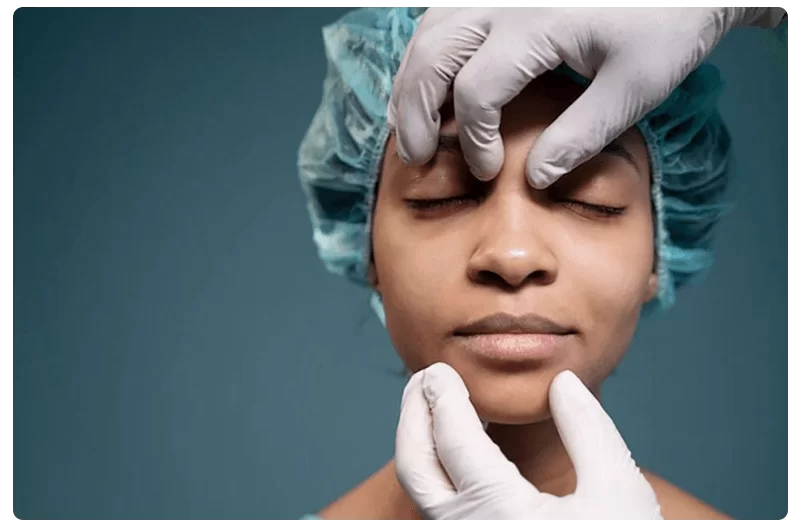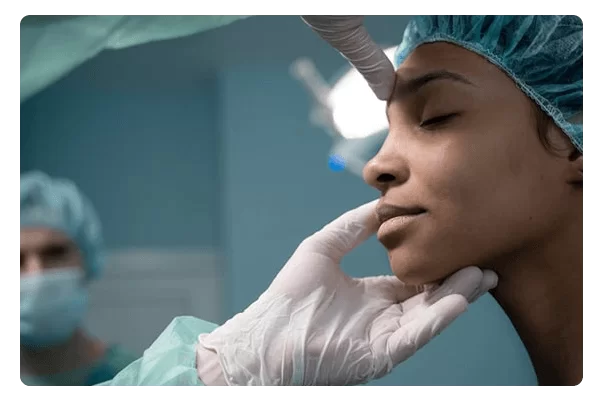Rhinoplasty in Abu Dhabi
Elyzee Hospital is one of the best medical centers in Abu Dhabi, specializing in Rhinoplasty.

Rhinoplasty: Enhancing Your Facial Harmony
Rhinoplasty also referred to as a ‘nose job’, is a transformative surgical procedure catering to a vast spectrum of individuals- those seeking better breathing abilities due to functional causes besides those desiring aesthetic enhancement in their facial features. The surgery focuses on reshaping and restructuring elements inside and outside an individual’s nasal passages with profound results for achieving overall facial balance and harmony.
Crooked noses, prominent humps on bridge areas are some examples that rhinoplasty corrects; thus making it one of the top-choice options for people worldwide who desire cosmetic improvements focused on their noses’ appearance.
The Benefits of this Procedure
The benefits of rhinoplasty extend beyond cosmetic improvements. They include:
1. Improved facial harmony
Rhinoplasty can enhance facial symmetry and balance by bringing the nose into proportion with other facial features. A well-proportioned nose can create a more aesthetically pleasing overall appearance.
2. Correcting functional issues
In addition to addressing aesthetic concerns, rhinoplasty can also improve nasal function. Correcting breathing difficulties is important for individuals who may have a deviated septum or narrow nasal passages hindering proper airflow. One effective way to address these issues is through medical intervention, which can help resolve the underlying problem and restore normal breathing patterns.


3. Increasing Self Assurance
People considering rhinoplasty often do so because they feel unhappy with the way their nose looks. Addressing these concerns through this procedure can have positive effects on one’s self worth and confidence levels.
4. Correcting trauma or injury
Rhinoplasty can also be performed to correct nasal deformities resulting from trauma or injury. It can restore the nose’s structure and function, allowing individuals to regain their pre-injury appearance.
The Best Candidate for this Procedure
The best candidate for rhinoplasty is someone who is in good overall health, has realistic expectations, and is unhappy with the appearance or functionality of their nose. Ideal candidates may have concerns such as a crooked nose, a hump on the bridge, a wide or narrow nasal base, or asymmetry. In order to address ones individual concerns about their nose it is imperative to have a comprehensive consultation with a certified plastic surgeon to decide if rhinoplasty is the suitable procedure.
Consultation with Doctor and Preparation for the Procedure
The first step towards a successful rhinoplasty treatment is booking an initial appointment with a qualified plastic surgeon who takes due diligence in identifying your key goals and scrutinizing your nasal structure while considering your unique physical needs. Crucial details are shared during this preliminary consultation; such as outlining particular procedures employed by your specialist aimed at achieving desirable results- These are broken down in comprehensive detail enabling you to make informed decisions about what works best for you. In addition to this, the surgical expert provides valuable advice on how best to prepare towards a swift recuperation phase whilst reducing potential risks like avoidance of certain drugs or supplements linked to ease bleeding.
What's Happening During the Procedure
Patients should be aware that rhinoplasty is typically performed with general anesthesia. The particular methods applied may vary depending on individual factors and a surgeons’ techniques. However most procedures include certain basic steps to achieve optimal results:
1. When patients undertake a decision about undergoing rhinoplasty–whether it involves an operation performed with either closed or open techniques–placement of incisions plays a significant role in determining outlooks surrounding surgery outcomes. Such decisions tend up being guided by several variables–everything from operational proficiency levels on behalf of their physician team involved to relative complexities in performing given portions of a anoplasty procedure tend up being factored into ultimate decisions made. Nevertheless, whatever modalities are settled upon between patient and physician beforehand, one thing is certain: a well-designed plan will be in order to ensure the most successful outcome possible for both parties involved.
2. Appropriately altering the shape of one’s nose involves meticulous adjustments made by an experienced surgeon. These adept alterations include carefully shaping both nasal bones and cartilage along with soft tissues to successfully achieve desired results. This may involve removing or adding cartilage, adjusting the nasal bridge, refining the nasal tip, or correcting any asymmetry.
3. To conclude the procedure, sutures are used by surgeons to close up any incisions made. To provide support and preserve its reshaped structure throughout recovery, nasal casts or splints might be inserted in specific situations.
After the Procedure and Recovery
After rhinoplasty, patients can expect some swelling, bruising, and discomfort. In order to achieve a smooth and effective post surgery outcome with minimum complications or discomforts it is necessary to carefully follow guidelines provided by medical professionals after undergoing a surgical procedure. This includes faithfully adhering to prescribed pain management medication along with specific instructions communicated by the surgical team which could involve keeping your head elevated during resting periods or refraining from certain physically demanding activities including getting enough rest time or exercises outlined by the medical team assigned as part of your aftercare plan following surgery preparations. Your full commitment towards following these meticulous protocols should guarantee a successful recovery process with no further setbacks or challenges encountered along the way towards optimal health maintenance.
A vital aspect of any cosmetic procedure post surgery stage involves careful management by both patient and surgeon alike. In general. Swelling and bruising tend to diminish over roughly two weeks from initial treatment- allowing most individuals to return successfully back into everyday life during that period without significant disruption. Its important to remember that visible physical transformations may not occur instantaneously post surgery but may become increasingly visible over time as healing continues that includes monitoring by healthcare professionals throughout your recovery journey.
Final Result
Rhinoplasty results usually become visible following several months of recovery period when all swelling has subsided entirely. At this point in your journey, you should be able to recognize a more balanced and proportionate look of your nose compared with other facial features; hence is aesthetically pleasing according to your preferences. Please also note all healing processes take some patience due to tissue settling which ultimately affects one’s final nasal shape.
Conclusion
Intending to modify the shape or function of ones nose through rhinoplasty requires careful consideration along with seasoned guidance from qualified professionals skilled at this highly specialized area of surgery. Patients who choose this transformative procedure expose themselves to multiple aesthetic advantages by reconstructing nasal structures providing better balance within overall facial features while simultaneously addressing practical issues like respiratory impediments caused by misshapen nasal passages or deviated septum. Achieving the best results calls for engaging reputable extensively trained and board-certified experts in rhinoplasty with a record of successfully delivering life-changing improvements in appearance and self-confidence to their satisfied patients.

FAQs
Under general anesthesia. Rhinoplasty is performed without causing pain. While recovery may be accompanied by discomfort and puffiness. This occurrence is frequent. The surgeon will prescribe pain medication to manage any discomfort.
Under general anesthesia. Rhinoplasty is performed without causing pain. While recovery may be accompanied by discomfort and puffiness. This occurrence is frequent. The surgeon will prescribe pain medication to manage any discomfort.
In the aftermath of this intervention a recovery phase lasting up to two weeks commences. Patients must prepare themselves for some degree of inflammation and minor bleeding during this crucial time span. Even though most people can resume their daily obligations within roughly two weeks post operation optimal results may only be noticeable some months later as any residual swelling naturally dissipates.
Like every surgery poses inherent risks so does rhinoplasty as well that should not be overlooked if considering undergoing the medical procedure. This includes peripheral issues like infection or bleeding problems along with likely complications involving the occurrence of asymmetry or scarring issues appearing after surgeries which could happen almost certainly during recovery periods if not taken care of correctly afterward.. Therefore one must take enough measures for going for only qualified professional experts who hold expertise in this field if hoping for best outcomes besides following every post-op protocol advised uniquely for better healing purposes altogether.
Achieving optimal facial rejuvenation often involves combining different surgical approaches, such as rhinoplasty and complementary facial procedures like chin augmentation or facelift surgery. This combined approach can help enhance overall balance and harmony throughout the face producing very satisfying results for the patient.
While often treated as a cosmetic procedure under health policy guidelines, Rhinoplasty can also be performed for those needing relief from impaired breathing due to structural blockages within their nose or sinus cavities. Depending on one’s specific health plan features , some health care policies may cover this medically indicated Rhinoplasty intervention . Checking with one’s insurer directly can provide better insight into their policy provisions and options available.
Make An Appointment

